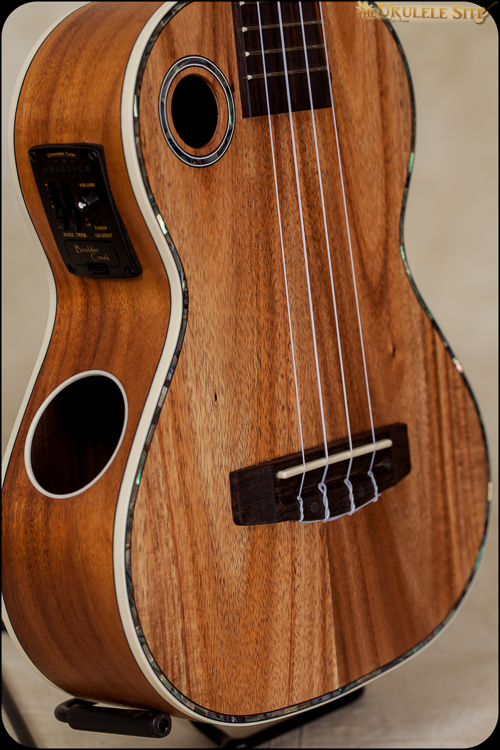 Riptide Ukulele is a fairly new series from Boulder Creek Guitars. This model is the EUT-11NS and has a solid Acacia top and laminate Acacia sides and back. It has electronics as you can see which feature an onboard tuner and EQ. This was sent to us by the company to sample and at first I wasn’t thrilled. I’ll tell you why.
Riptide Ukulele is a fairly new series from Boulder Creek Guitars. This model is the EUT-11NS and has a solid Acacia top and laminate Acacia sides and back. It has electronics as you can see which feature an onboard tuner and EQ. This was sent to us by the company to sample and at first I wasn’t thrilled. I’ll tell you why.
The guys in our setup department would probably take a pay cut if I agreed to not carry anything with this style of electronics. The side mounted preamp or wires running through the body buzz at certain frequencies. Not all the time, but 90% of the time, and it can take an extra 15 minutes or more to troubleshoot and fix the issue. So that was my first observation was buzz from electronics. Next I felt the string height at the nut, way too high and the action I measured at almost 4mm at the 12th fret. So I packed it up and it sat for the last month or more.
The other day I looked again, made a few quick adjustments. I played, listened, and thought, ya know, it sounds pretty good! Lots of volume and a full bodied tone. I thought, maybe I wasn’t being fair to dismiss this uke.
This Riptide tenor sells for under $300. Everything in this price range needs final work. After giving it the time of day, I realized that this has a tone that will compete quite well with others in it’s price range. The electronics sound pretty good and the overall look is cool and unique. The intonation is correct, the sustain is great, and the neck is set correct so improvements are possible in final setup. All in all, the Riptide EUS 11NS is a valid contender for an electric tenor under 300.
Boulder Creek Guitars design around a different concept and structure. This model had the offset soundhole which gives more soundboard to sustain and less support needed without the large hole in the middle. The side port is another great aspect of the design. Most of us play to ourselves, for our own enjoyment. This port is positioned on the lower bout and angles right at you. The sound comes through clean and clear.It’s positioning makes perfect sense.
Have you tried these ukes? Give us your take on them if you have. I gotta say, after giving it a shot, I was kind of impressed.
Corey Fujimoto samples…

Comments 6
Nice ukulele…what impresses me the most is the “final work” and setup your guys do in the shop, Andrew. I started with a couple of ukes in this price range I bought locally before I knew of HMS and they didn’t play that well. A $300 to $400 ukulele with your setup is a bargain overall. Thanks for these reviews. Very helpful.
I need to weigh on the “this style of electronics” critique, because my HMS-supplied Islander MT4-GPU doesn’t have any buzz or extraneous sounds related to the electronics. Maybe that’s because HMS worked on it before it got to me.
In a way, the lack of buzzing is surprising, because I can see wires inside just sort of laying there against the body; no attempt to restrain or capture or control the wire routing. If there’s a culprit in “this style of electronics,” it’s sloppiness of installation, not some inherent issue or flaw with side mounted EQ’s. A simple foam grommet would be very effective, and take a mere moment to install.
In another way, there’s cause for pause, here, in that shelling up $400.00 is held to be a “low-end” or “minor” expenditure, and expectations of quality control are lowered down at this end for no justifiable reason.
It’s a big cop-out, really. $400 bucks is not chump change, it’s a major investment for lots of folks. Granted that higher end ukes run to thousands, that doesn’t mean $400 is a trivial outlay of cash.
Some folks work darned hard to save up that much money (I did); they deserve more consideration than being relegated to some convenient-for-the-industry, but totally imaginary “lower-end” status.
(Definitely on the soapbox, here, but the point needs to be reaffirmed, or it gets lost in enthusiasms; hey, if only spend a few hundred MORE bucks, I could get a….!.)
The manufacturers could use a level-headed talking-to about taking more basic design-level care of where and how the wires are being routed. That ten-minute, one-time procedure during the design phase would eliminate 80% of the 90% of buzz and noise issues.
Just common sense, and good-practice.
My extraneous-noise-free acoustic-electric Islander is a sweet, sweet joy to play, and I’m very appreciative of Hawaii Music Supply for setting it up for me.
Thanks, again, Andrew and company..
I love the riptide look to ukuleles.
I’ve got the solid spruce top, rosewood sides tenor model and find it a joy to play.
Great Review! What a beautiful Uke.
I too own a spruce top, rosewood back and sides version.
I also have problems with a buzz but, have traced it to the battery compartment. At certain frequencies the batteries seem vibrate against each other.
I then slide the battery “shelf” out and place back in and the buzz goes away.
YMMV